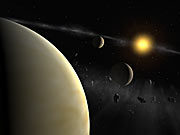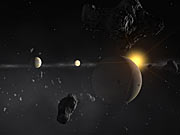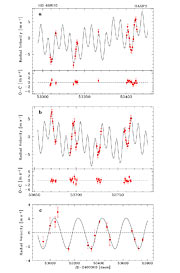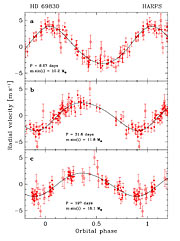Pressemitteilung
Trio of Neptunes and their Belt
HARPS Instrument Finds Unusual Planetary System
18. Mai 2006
Using the ultra-precise HARPS spectrograph on ESO's 3.6-m telescope at La Silla (Chile), a team of European astronomers have discovered that a nearby star is host to three Neptune-mass planets. The innermost planet is most probably rocky, while the outermost is the first known Neptune-mass planet to reside in the habitable zone. This unique system is likely further enriched by an asteroid belt.
"For the first time, we have discovered a planetary system composed of several Neptune-mass planets", said Christophe Lovis, from the Geneva Observatory and lead-author of the paper presenting the results [1].
During more than two years, the astronomers carefully studied HD 69830, a rather inconspicuous nearby star slightly less massive than the Sun. Located 41 light-years away towards the constellation of Puppis (the Stern), it is, with a visual magnitude of 5.95, just visible with the unaided eye. The astronomers' precise radial-velocity measurements [2] allowed them to discover the presence of three tiny companions orbiting their parent star in 8.67, 31.6 and 197 days.
"Only ESO's HARPS instrument installed at the La Silla Observatory, Chile, made it possible to uncover these planets", said Michel Mayor, also from Geneva Observatory, and HARPS Principal Investigator. "Without any doubt, it is presently the world's most precise planet-hunting machine" [3].
The detected velocity variations are between 2 and 3 metres per second, corresponding to about 9 km/h! That's the speed of a person walking briskly. Such tiny signals could not have been distinguished from 'simple noise' by most of today's available spectrographs.
The newly found planets have minimum masses between 10 and 18 times the mass of the Earth. Extensive theoretical simulations favour an essentially rocky composition for the inner planet, and a rocky/gas structure for the middle one. The outer planet has probably accreted some ice during its formation, and is likely to be made of a rocky/icy core surrounded by a quite massive envelope. Further calculations have also shown that the system is in a dynamically stable configuration.
The outer planet also appears to be located near the inner edge of the habitable zone, where liquid water can exist at the surface of rocky/icy bodies. Although this planet is probably not Earth-like due to its heavy mass, its discovery opens the way to exciting perspectives.
"This alone makes this system already exceptional", said Willy Benz, from Bern University, and co-author. "But the recent discovery by the Spitzer Space Telescope that the star most likely hosts an asteroid belt is adding the cherry to the cake."
With three roughly equal-mass planets, one being in the habitable zone, and an asteroid belt, this planetary system shares many properties with our own solar system.
"The planetary system around HD 69830 clearly represents a Rosetta stone in our understanding of how planets form", said Michel Mayor. "No doubt it will help us better understand the huge diversity we have observed since the first extra-solar planet was found 11 years ago."
High resolution images and their captions are available on this page. Video footage and animations are also available on this page.
Endnoten
[1]: These results appear in the 18 May issue of the research journal Nature ("Discovery of an extrasolar planetary system with three Neptune-Mass Planets", by C. Lovis et al.). The team is composed of Christophe Lovis, Michel Mayor, Francesco Pepe, Didier Queloz, and Stéphane Udry (Observatoire de l'Université de Genève, Switzerland), Nuno C. Santos (Observatoire de l'Université de Genève, Switzerland, Centro de Astronomia e Astrofisica da Universidade de Lisboa and Centro de Geofisica de Evora, Portugal), Yann Alibert, Willy Benz, Christoph Mordasini (Physikalisches Institut der Universität Bern, Switzerland), François Bouchy (Observatoire de Haute-Provence and IAP, France), Alexandre C. M. Correia (Universidade de Aveiro, Portugal), Jacques Laskar (IMCCE-CNRS, Paris, France), Jean-Loup Bertaux (Service d'Aéronomie du CNRS, France), and Jean-Pierre Sivan (Laboratoire d'Astrophysique de Marseille, France).
[2]: A planet in orbit around a star will manifest its presence by pulling the star in different directions, thereby changing by rather small amounts its measured velocity. Astronomers therefore measure with very high precision the velocity of a star to detect the signature of one or more planets.
[3]: The High Accuracy Radial velocity Planet Searcher (HARPS) at the ESO La Silla 3.6-m telescope is dedicated to the discovery of extrasolar planets. It is a fibre-fed high-resolution echelle spectrograph that has demonstrated a long-term precision of about 1 m/s.
Kontaktinformationen
Christophe Lovis
Observatoire de l'Université de Genève
Geneva, Switzerland
Tel: +41 22 379 24 07
E-Mail: Christophe.Lovis@obs.unige.ch
Michel Mayor
Observatoire de l'Université de Genève
Geneva, Switzerland
Tel: +41 22 379 24 60
E-Mail: Michel.Mayor@obs.unige.ch
Yann Alibert
Physikalisches Institut der Universität Bern
Bern, Switzerland
Tel: +41 31 631 44 27
E-Mail: yann.alibert@phim.unibe.ch
Willy Benz
Physikalisches Institut der Universität Bern
Bern, Switzerland
Tel: +41 31 631 44 03
E-Mail: willy.benz@phim.unibe.ch
Über die Pressemitteilung
| Pressemitteilung Nr.: | eso0618 |
| Legacy ID: | PR 18/06 |
| Name: | HD 69830 |
| Typ: | Milky Way : Star : Circumstellar Material : Planetary System |
| Facility: | ESO 3.6-metre telescope |
| Instruments: | HARPS |
| Science data: | 2006Natur.441..305L |
Our use of Cookies
We use cookies that are essential for accessing our websites and using our services. We also use cookies to analyse, measure and improve our websites’ performance, to enable content sharing via social media and to display media content hosted on third-party platforms.
ESO Cookies Policy
The European Organisation for Astronomical Research in the Southern Hemisphere (ESO) is the pre-eminent intergovernmental science and technology organisation in astronomy. It carries out an ambitious programme focused on the design, construction and operation of powerful ground-based observing facilities for astronomy.
This Cookies Policy is intended to provide clarity by outlining the cookies used on the ESO public websites, their functions, the options you have for controlling them, and the ways you can contact us for additional details.
What are cookies?
Cookies are small pieces of data stored on your device by websites you visit. They serve various purposes, such as remembering login credentials and preferences and enhance your browsing experience.
Categories of cookies we use
Essential cookies (always active): These cookies are strictly necessary for the proper functioning of our website. Without these cookies, the website cannot operate correctly, and certain services, such as logging in or accessing secure areas, may not be available; because they are essential for the website’s operation, they cannot be disabled.
Functional Cookies: These cookies enhance your browsing experience by enabling additional features and personalization, such as remembering your preferences and settings. While not strictly necessary for the website to function, they improve usability and convenience; these cookies are only placed if you provide your consent.
Analytics cookies: These cookies collect information about how visitors interact with our website, such as which pages are visited most often and how users navigate the site. This data helps us improve website performance, optimize content, and enhance the user experience; these cookies are only placed if you provide your consent. We use the following analytics cookies.
Matomo Cookies:
This website uses Matomo (formerly Piwik), an open source software which enables the statistical analysis of website visits. Matomo uses cookies (text files) which are saved on your computer and which allow us to analyze how you use our website. The website user information generated by the cookies will only be saved on the servers of our IT Department. We use this information to analyze www.eso.org visits and to prepare reports on website activities. These data will not be disclosed to third parties.
On behalf of ESO, Matomo will use this information for the purpose of evaluating your use of the website, compiling reports on website activity and providing other services relating to website activity and internet usage.
Matomo cookies settings:
Additional Third-party cookies on ESO websites: some of our pages display content from external providers, e.g. YouTube.
Such third-party services are outside of ESO control and may, at any time, change their terms of service, use of cookies, etc.
YouTube: Some videos on the ESO website are embedded from ESO’s official YouTube channel. We have enabled YouTube’s privacy-enhanced mode, meaning that no cookies are set unless the user actively clicks on the video to play it. Additionally, in this mode, YouTube does not store any personally identifiable cookie data for embedded video playbacks. For more details, please refer to YouTube’s embedding videos information page.
Cookies can also be classified based on the following elements.
Regarding the domain, there are:
- First-party cookies, set by the website you are currently visiting. They are stored by the same domain that you are browsing and are used to enhance your experience on that site;
- Third-party cookies, set by a domain other than the one you are currently visiting.
As for their duration, cookies can be:
- Browser-session cookies, which are deleted when the user closes the browser;
- Stored cookies, which stay on the user's device for a predetermined period of time.
How to manage cookies
Cookie settings: You can modify your cookie choices for the ESO webpages at any time by clicking on the link Cookie settings at the bottom of any page.
In your browser: If you wish to delete cookies or instruct your browser to delete or block cookies by default, please visit the help pages of your browser:
Please be aware that if you delete or decline cookies, certain functionalities of our website may be not be available and your browsing experience may be affected.
You can set most browsers to prevent any cookies being placed on your device, but you may then have to manually adjust some preferences every time you visit a site/page. And some services and functionalities may not work properly at all (e.g. profile logging-in, shop check out).
Updates to the ESO Cookies Policy
The ESO Cookies Policy may be subject to future updates, which will be made available on this page.
Additional information
For any queries related to cookies, please contact: pdprATesoDOTorg.
As ESO public webpages are managed by our Department of Communication, your questions will be dealt with the support of the said Department.






